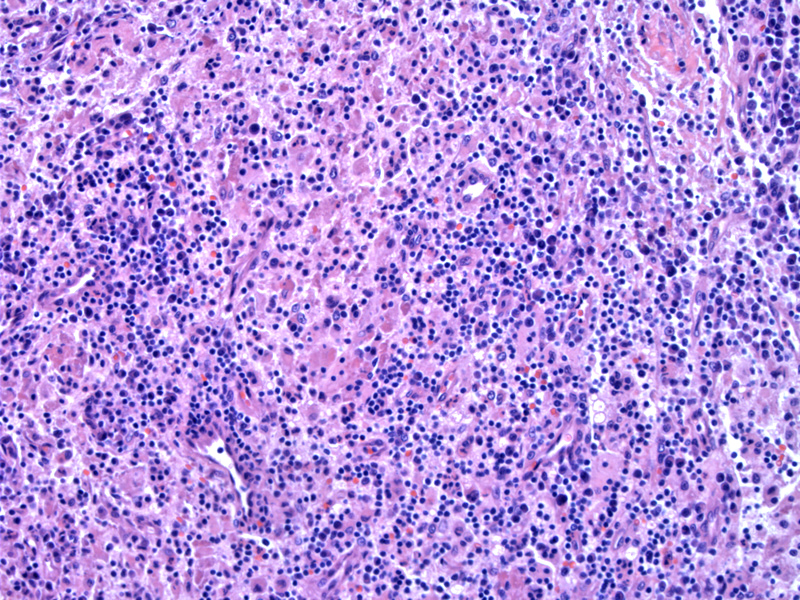

Case 1: The nodes are markedly enlarged and the sinuses are expanded by histiocytes.
The histiocytes have pink foamy cytoplasm.
Case 2 - The lymph node architecture is usually preserved, but may be distorted due to the abundance of histiocytes filling the sinuses.
The cytoplasm is abundant, pink and foamy and may contain phagocytosed lymphocytes (lymphophagocytosis) or other types of cells such as RBCs, neutrophils, plasma cells -- a phenomenon called emperipoleisis (Weiss, Rodriguez-Galindo). Emperipolesis (ie, histiocytes containing lymphocytes, plasma cells, neutrophils, and erythrocytes) is a characteristic pathologic feature of this disease.
The histiocytes stain strongly with S100. They will also be CD1 and CD68 positive (histiocyte markers), but will be negative for CD1a (Langerhan cell marker) or CD21 and CD35 (dendritic cell markers)(Weiss). By comparison, typical macrophages are CD68(+), S-100(-), and CD1a(-), and many types of dendritic cells are CD68(-), S-100(+), and CD1a(+).
Case 3: Another example that has paler cytoplasm.
Sinuses are expanded by foamy histiocytes.
A closer look at the numerous histiocytes. A small nucleolus is often present. Emperipolesis is not obvious here.
Rosai-Dorfman disease, also known as "sinus histiocytosis with massive lymphadenopathy", is a rare idiopathic condition characterized by a proliferation of histiocytes within the lymph nodes. It is most commonly seen in children and presents with massive cervical lymphadenopathy and constitutional symptoms such as fever and leukocytosis. Originally described in 1960s by Rosai and Dorfman, over 650 cases have been reported thus far. The etiology is unknown, although some authors suggest immune dysregulation may play a role (Weiss).
The condition may occur either in lymph nodes , extra-nodal locations , or both simultaneously. Extranodal involvement occurs in approximately 30-40% of patients, which may involve the head and neck, paranasal sinuses, orbit, central nervous system, kidneys, upper respiratory tract, gastrointestinal tract, testicles, temporal bone, and salivary glands (Foucar).
Children are most often affected, although this disease may be seen in all ages. Those of African descent are more frequently affected. Lymphadenopathy, typically cervical, is the most common presentation and is seen in >95% of patients. This is often associated with fever and leucocytosis.
Treatment options include observation, surgery or chemotherapy and radiation. In a prior review, it was found that the asymptomatic patients tended to be observed, while symptomatic patients (defined as those with recurrent fever or rapid lymph node swelling) were treated with surgical debulking. Radiation and chemotherapy have had limited success (Pulsoni).
May undergo spontaneou remission. Rarely death has been reported due to extensive infiltration of visceral organs.
→RDD is a rare nonneoplastic histiocytic disorder that predominantly presents with massive cervical lymphadenopathy, fever and leukocytosis.
→Extranodal involvement is present in 40% of cases.
→RDD tends to affect children and those of African descent.
→The histiocytes express monocyte/macrophage-associated antigen and are usually positive for S100.
→Histologically, the sinusoids of the lymph nodes are stuffed with histiocytes, which contain phagocytosed lymphocytes as well as RBCs, plasma cells and neutrophils. This phenomenon is called emperipolesis is distinctive of RDD.
• Sinonasal : Rosai-Dorfman Disease
• Dermis : Cutaneous Rosai-Dorfman Disease
Foucar E, Rosai J, Dorfman R. Sinus histiocytosis with massive lymphadenopathy (Rosai-Dorfman disease): review of the entity. Semin Diagn Pathol. 1990 Feb;7(1):19-73.
Pulsoni A, et al. Treatment of sinus histiocytosis with massive lymphadenopathy (Rosai-Dorfman disease): report of a case and literature review. Am J Hematol. 2002 Jan;69(1):67-71.
Rodriguez-Galindo C, Helton KJ, et al. Extranodal Rosai-Dorfman disease in children. J Pediatr Hematol Oncol. 2004 Jan;26(1):19-24.
Shi Y, Griffin AC, Zhang PJ, Palmer JN, Gupta P. Sinus histiocytosis with massive lymphadenopathy (Rosai-Dorfman Disease): A case report and review of 49 cases with fine needle aspiration cytology. Cytojournal. 2011 Feb 12;8:3.
Weiss SW, Goldblum JR. Enzinger. Enzinger and Weiss' Soft Tissue Tumors. 5th Ed. Philadelphia, PA: Elsevier; 2008: 53-6.
